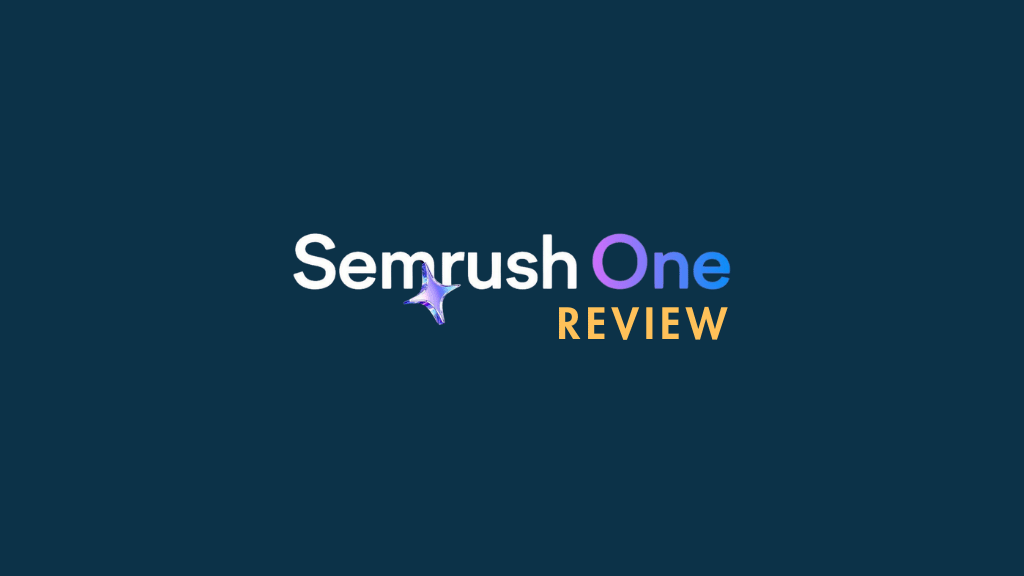
In this Semrush One review, we walk you through all the pros and cons of the new ‘AI SEO’ version of Semrush.
Semrush has been a heavyweight in the SEO world for well over a decade, functioning as a central hub for keyword research, site auditing, competitor analysis, and rank tracking for many businesses.
But as the search landscape shifts towards AI-generated answers, conversational discovery, and zero-click experiences, Semrush has decided to rethink what its platform should be. The result of this rethink is Semrush One, recently announced at its annual Spotlight conference. This is a significantly expanded version of the platform that aims to cover not just traditional SEO, but the new world of AI visibility too.
So, in this review, I’m going to walk you through what Semrush One actually is, the advantages it offers, and the drawbacks you should be aware of. If you’re weighing up whether to stay with Semrush, upgrade to the Semrush One package, or explore alternatives, this review is for you.
Quick verdict
Semrush One is a significant, future-focused upgrade to the classic Semrush platform. It combines Semrush’s already comprehensive SEO toolkit with an impressive suite of AI visibility features, giving you a unified view of how your brand appears across both traditional search results and emerging AI-driven environments. This combination makes it one of the most complete visibility solutions currently available.
It is, however, a premium product. Pricing is high, only one seat is provided regardless of plan, and AI tracking doesn’t yet extend to some key platforms (for example Claude and Perplexity). But for businesses that want to stay ahead of shifts in search behavior — and understand how both Google and LLMs are presenting their brand — Semrush One is one of the best tools of its kind on the market.
What is Semrush One?
Semrush One is the company’s new flagship product tier. At its core, it still offers everything that users have historically relied on Semrush for, namely:
- keyword research
- domain analysis
- content optimization tools
- site auditing
- rank tracking
- backlink intelligence
- outreach tools
- competitive research data
What differentiates Semrush One from the previous incarnation of the product however is the fact that it includes Semrush’s newly developed AI Visibility Toolkit — a bundle of features that aim to help you understand how your brand is appearing in AI-driven environments (ChatGPT Search, Google’s AI Overviews, and Google AI Mode).
This represents a pretty significant shift in focus for Semrush. In the past, its goal was to be the most comprehensive SEO platform available. With Semrush One, the goal is broader: the aim here is to become a visibility platform, showing you how your brand performs wherever users are discovering information — whether that’s on Google’s traditional search results pages or inside an LLM-powered summary.
The AI Visibility Toolkit works alongside the classic SEO features, tracking how often a brand appears in AI-generated answers, whether those answers cite your content, which specific pages are being referenced, and which topics or prompts tend to surface your business. On top of that, it highlights the sentiment that AI systems associate with your brand.
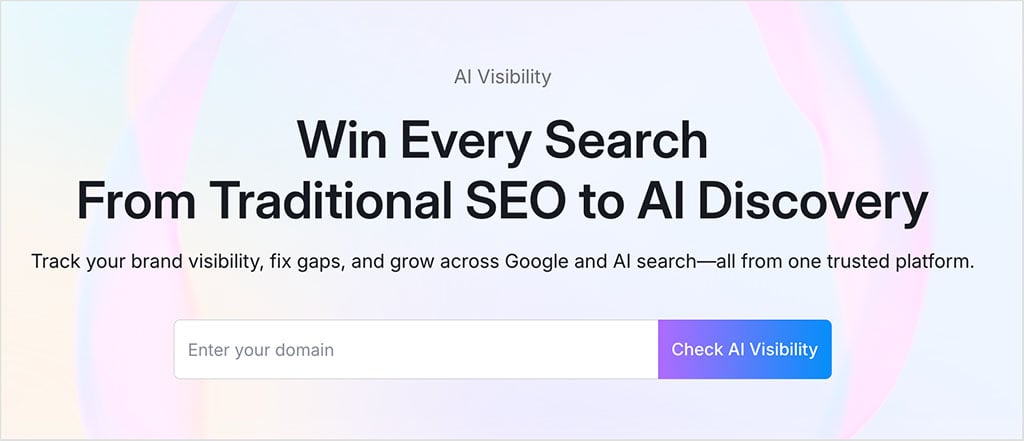
To make sure your content is actually available for LLMs to analyze, the toolkit checks whether AI agents can crawl your site successfully — and flags any technical roadblocks that could limit visibility. And because prompts are becoming a kind of “new keyword,” Semrush One includes tools for tracking how these prompts change over time — and whether your brand’s presence within them is rising or falling.
Semrush One comes in three pricing tiers — Starter, Pro+ and Advanced — with each tier offering increasingly generous limits around keywords, prompts, projects, and reports (more on pricing shortly). But the defining feature across all tiers is the inclusion of full AI visibility monitoring, something that is not currently included in Semrush’s cheaper “SEO Classic” plans.
In short, Semrush One is Semrush’s attempt to prepare users for a search landscape where links, snippets, citations and AI-generated summaries sit side by side.
But is it any good? To help you find out, I’ll walk you through Semrush One’s key advantages and disadvantages now.
Advantages of Using Semrush One
1. It brings AI visibility and traditional SEO into one unified workflow
For all the current excitement around AI, it’s worth remembering that far more people still use Google for search purposes than they do LLMs. Recent data indicates that while 66 million searches per day are performed on ChatGPT, 16 billion are performed on Google.
This means that focusing on traditional SEO alongside LLM optimization remains incredibly important — and one of the biggest advantages of Semrush One is that it lets you monitor SEO performance and AI visibility from the same dashboard.
There’s no doubting the direction of travel though: AI-generated answers are already influencing discovery, brand awareness and purchasing decisions — and that’s a trend that looks set to accelerate (especially if/when Google’s AI Mode becomes the default search experience).
So at this juncture, having access to both SEO and AI visibility data is incredibly important. For example, you might rank highly for a keyword in Google — but barely appear in AI-generated summaries for the same topic. Conversely, your brand might feature prominently in AI-driven answers about an industry trend, even though you don’t yet rank well for the associated search terms.
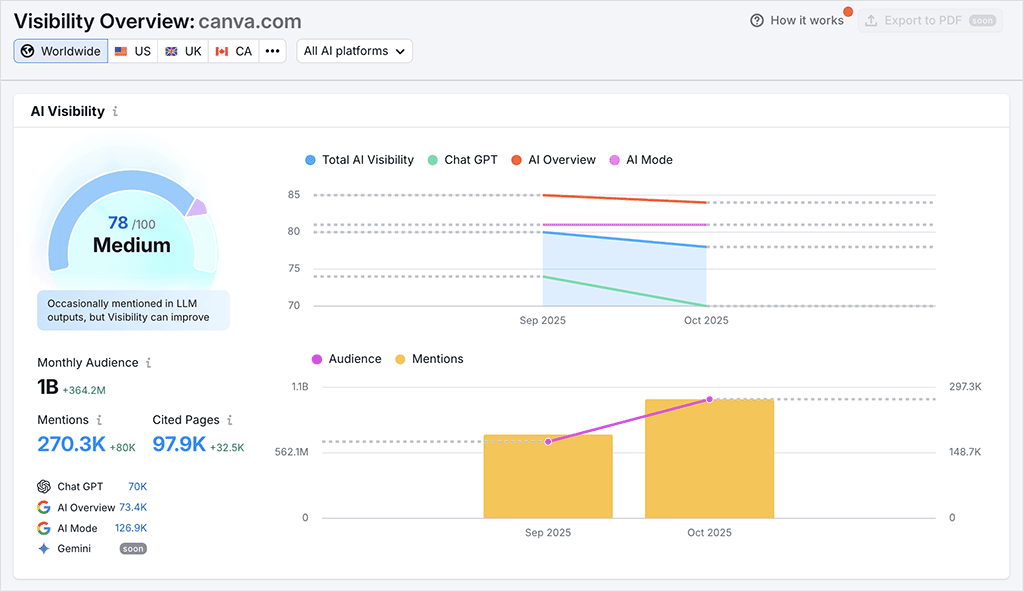
Being able to compare traditional SEO visibility with AI visibility using one tool gives you a much more complete picture of the opportunities ahead — and any blind spots you need to fix.
And Semrush’s new AI visibility features are comprehensive, and arguably best-in-class. They tell you:
- how AI platforms are talking about your brand
- whether your site is cited in AI-generated answers
- how often your brand appears in generative results
- which prompts trigger your presence
- whether AI agents can crawl your site
- how your visibility changes over time
- how competitors appear in AI responses
When testing these features in Semrush One, I was really impressed by just how exhaustive the AI visibility data provided was — and just as importantly, how easy to navigate it was.
2. It introduces prompt research and tracking
One of the most distinctive aspects of Semrush One — and a feature that separates it very clearly from traditional SEO platforms — is its ability to let you research and track prompts.
As AI-driven search interfaces continue to reshape user behavior, prompts are quickly becoming the new “keywords”: the building blocks people use to explore topics and retrieve answers in LLM-powered environments.
Prompt research
In terms of its prompt research capabilities, a simple interface lets you enter a topic to analyze prompts for; when you do so, Semrush shows you the relevant AI prompts that are currently being used to explore that topic (grouped by sub-topic).
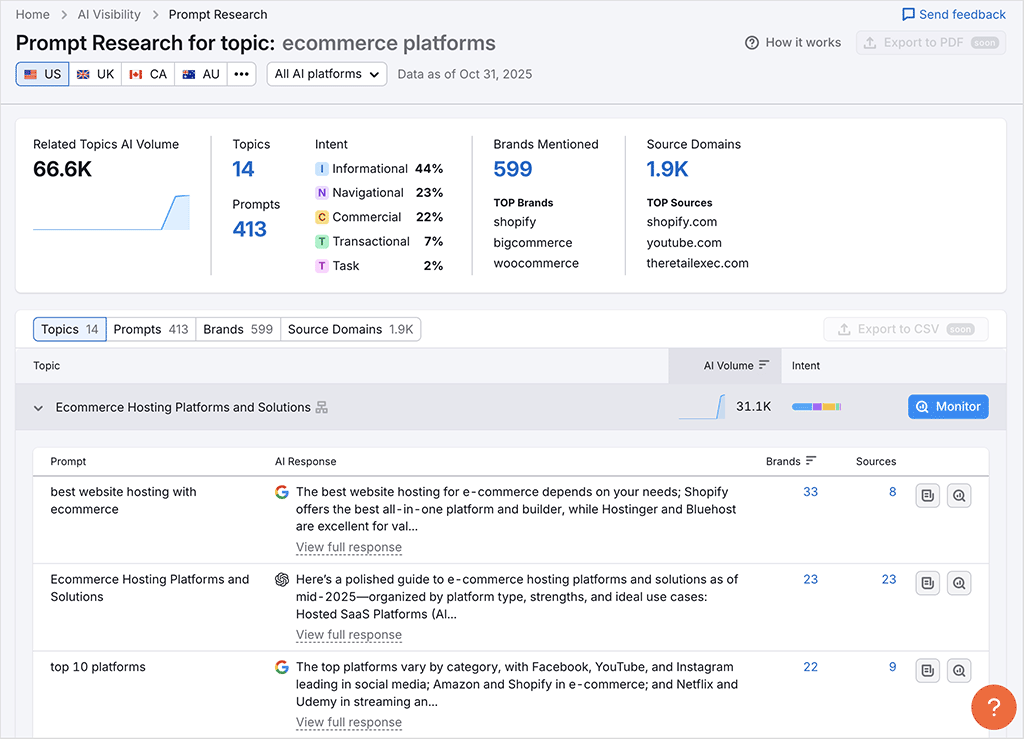
I tested this out by entering ‘ecommerce platforms’ into the prompt research tool — as you can see from my screenshot above, I then received a list of sub-topics and associated prompts that I could consider building new content around. A lot of these provided interesting food for thought — in the form of several article ideas that I hadn’t previously considered when conducting traditional keyword research.
Prompt tracking
Semrush One also provides a structured way to monitor prompts over time, letting you see how your brand appears inside the questions, instructions and thematic prompts users feed into conversational tools (currently, Semrush lets you track prompts in ChatGPT Search and Google AI Mode). In doing so, it effectively extends SEO into the world of generative search.
If you select ChatGPT Search or Google AI Mode during the position tracking setup process, you can see how your site (or brand) is performing for those prompts — this works in a similar way to traditional rank tracking, and helps provide a lot of clarity into what’s actually happening within two key LLMs.
3. It lets you know how your brand is perceived by AI
Semrush One doesn’t just tell you whether AI tools mention your brand — it shows you how they feel about you.
Its perception tools analyze the tone, sentiment and messaging inside AI-generated answers, giving you a clear sense of whether ChatGPT Search or Google’s AI Mode are presenting your business positively, neutrally or in ways that need correcting (if possible to do so!). Insights are provided in a clear, easy-to-digest way.

Because this analysis is tied to real prompts and real topics, you see how AI describes your brand in the exact contexts that matter: product comparisons, “best X” lists, how-to queries, and broader industry explanations. That makes it easy to spot strengths that AI consistently amplifies — and weaknesses or misconceptions that might be costing you visibility.
4. It retains Semrush’s market-leading keyword research capabilities
Keyword research remains central to any SEO strategy, and Semrush has long been known as one of the most sophisticated keyword discovery tools available (our full Semrush review explains why).
Semrush One includes all these keyword research features, letting you analyze search volumes, keyword difficulty, cost-per-click estimates, SERP features, competitor rankings, related queries, and longer-tail opportunities.
For me, one of the standout features here — representing a major advantage over most rival platforms — is Semrush’s personalized keyword difficulty scoring. This uses AI to analyze your domain’s topical authority and calculate keyword difficulty scores specifically for your site.
It recognizes that the ability to rank for a keyword varies dramatically from domain to domain, and accordingly presents a personalized, domain-adjusted difficulty score that shows how realistically you could compete for particular keywords.

5. It gives you some of the best link building tools available
Semrush One includes the platform’s full suite of link building tools, and they remain considerably stronger than those offered by most competing platforms.
This is because Semrush doesn’t just give you a list of potential backlink sources, but a complete workflow.
First, the platform analyzes your site, your competitors, and your niche and then generates a curated list of link prospects based on competitive gaps, authority metrics and topical relevance.
Then it lets you connect your email account directly to its link building tool, create outreach templates, send pitches and track the outcome of each approach — all without leaving the Semrush interface.
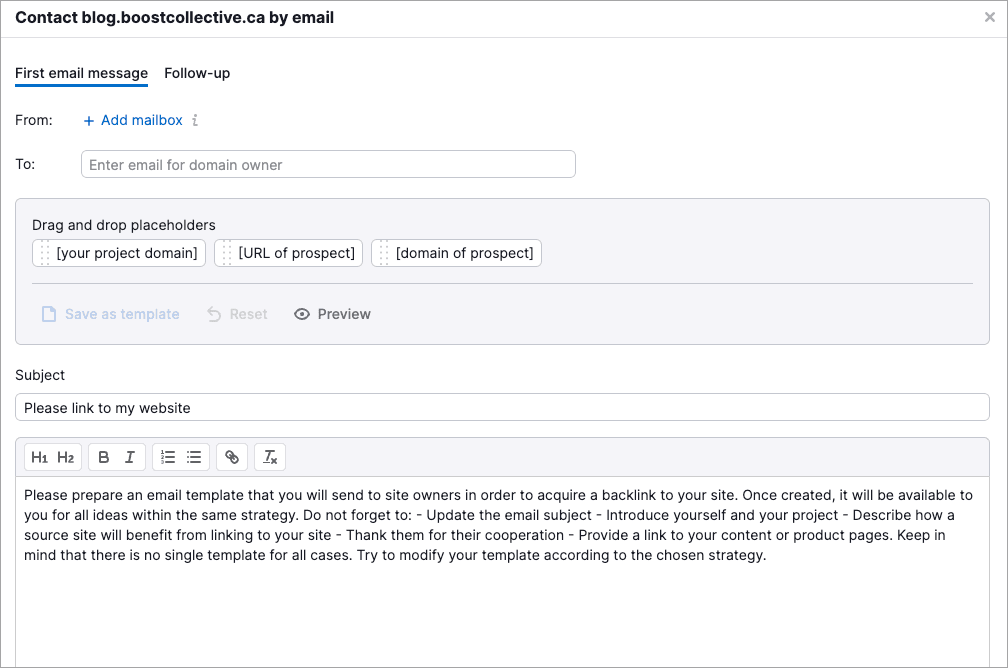
The tool effectively becomes a lightweight CRM for backlink campaigns, which makes it incredibly useful for agencies and in-house SEO teams alike.
6. Its site auditing features are comprehensive and genuinely actionable
The Semrush site audit checks for a wide array of technical SEO issues — slow pages, crawl errors, duplicate content, missing metadata, JavaScript rendering problems, broken links, Core Web Vitals issues and much more.
One of the things I like most here is that the audit results tell you how to fix each issue, via helpful contextual notes. This makes things particularly accessible to beginners.
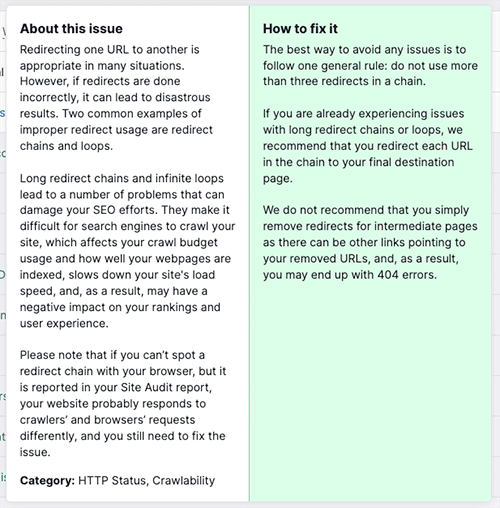
As you can see from my screenshot below, Semrush’s auditing tool now includes AI Search Health checks. These basically evaluate whether AI engines can actually crawl and process your site properly. If your content is blocked — or if certain files inadvertently limit the crawlability of your pages — Semrush One will flag it.
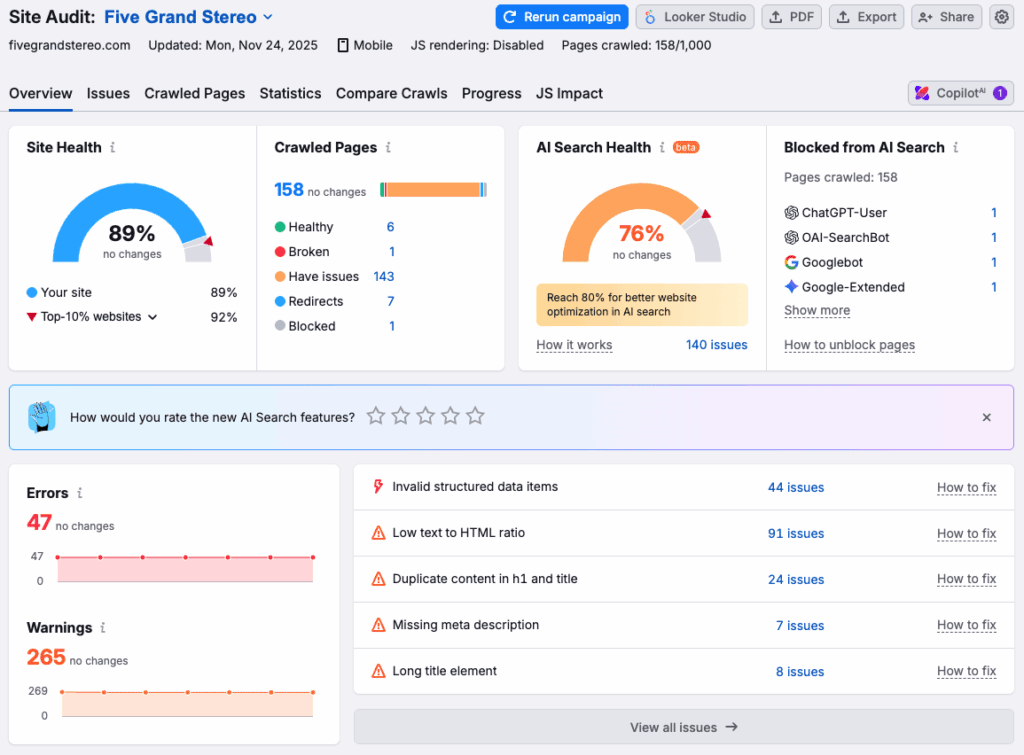
7. It provides detailed position tracking, including in AI Overviews
Position tracking remains central to measuring SEO success, and Semrush One’s capabilities here are strong. It lets you track organic rankings on a daily basis, compare them against those of your competitors, monitor changes across countries, set up automated alerts, and receive weekly summary reports.
Significantly, its position tracking tools also show you you when your content appears in Google’s AI Overviews — those short AI-generated summaries that sometimes appear above the traditional search results. Since these summaries can significantly influence click-through rates, understanding your visibility within them is extremely valuable.
A standout feature for me here is the “potential growth” indicator. This highlights keywords where improving your content could unlock the greatest increases in traffic. It’s a clever tool, because it encourages you to optimize existing content where there’s clear upside — and get quick visibility wins that you might have otherwise overlooked.
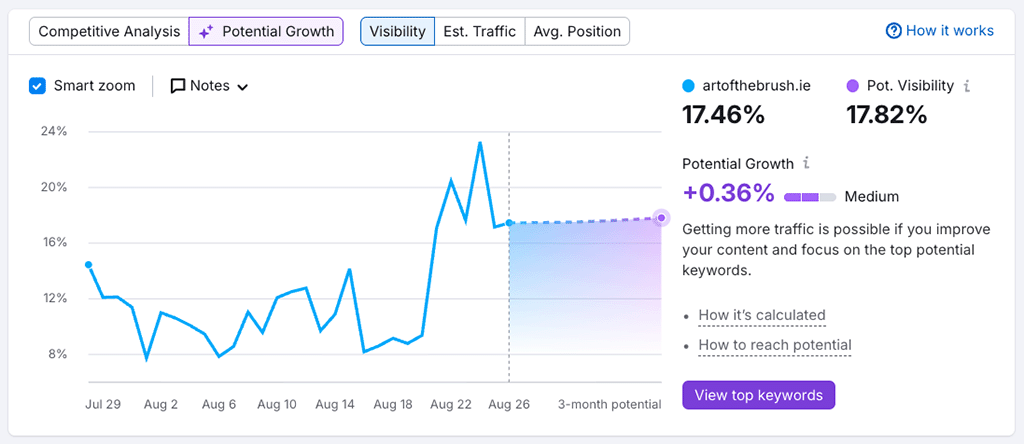
8. Its reporting limits are more generous than most competitors
Many SEO tools impose strict limits on how much data you can pull each month, particularly on their cheaper plans. Helpfully, Semrush offers significantly more generous allowances on its lower-tier plans than competing solutions.
Even its entry-level plan gives you access to thousands of reports per day, making Semrush One particularly appealing to users who need to analyze multiple domains or run data-heavy workflows.
These generous limits make Semrush One well suited to agencies, larger marketing departments and content teams that frequently dive into competitor sites or explore large keyword lists.
9. Customer support is multi-channel
Semrush is one of the few SEO platforms on the market that still offers support via multiple channels — you can contact the company via phone, email, and live chat.
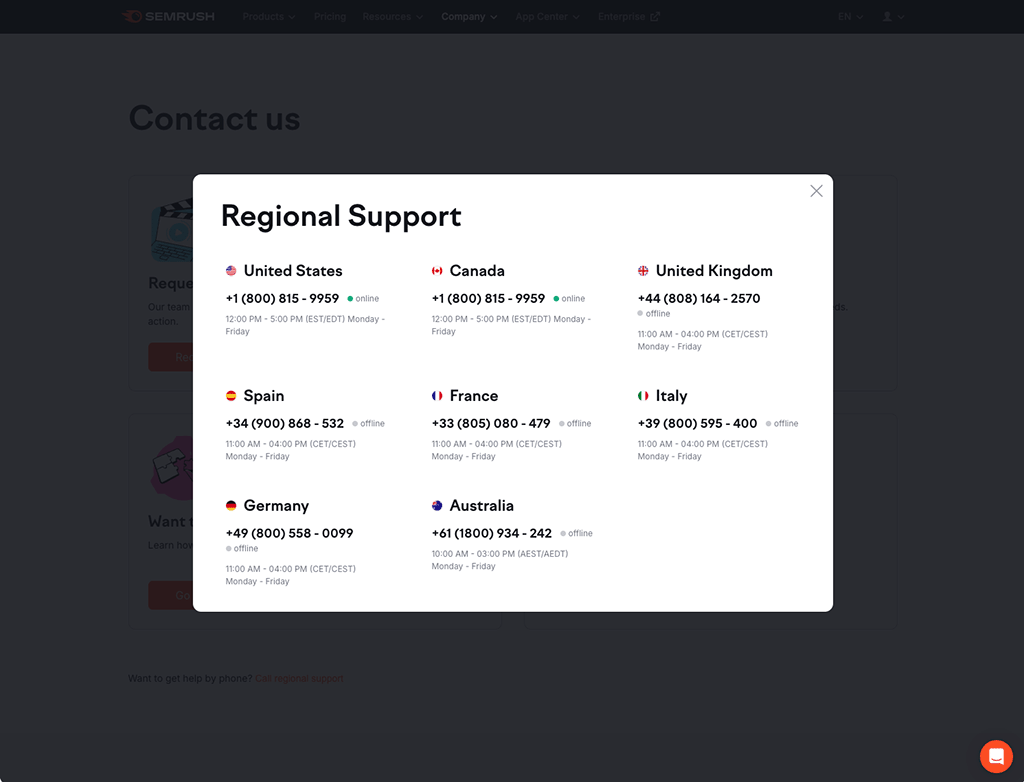
For context, Moz only offers email support, and Ahrefs doesn’t provide phone support.)
This comprehensive support offering is particularly helpful if you’re using Semrush One in an agency or enterprise context, where fast resolution of issues is important.
Disadvantages of Using Semrush One
1. It’s expensive
Semrush One is positioned at the premium end of the market. Starting at $199 per month, it’s noticeably more expensive than entry-level SEO and AI visibility monitoring tools.
For context, the standalone AI visibility tool Profound starts at $99 per month, and the AI tracking features in SE Ranking — a tool which like Semrush offers a mix of SEO and AI visibility tools — can be availed of from $119 per month.
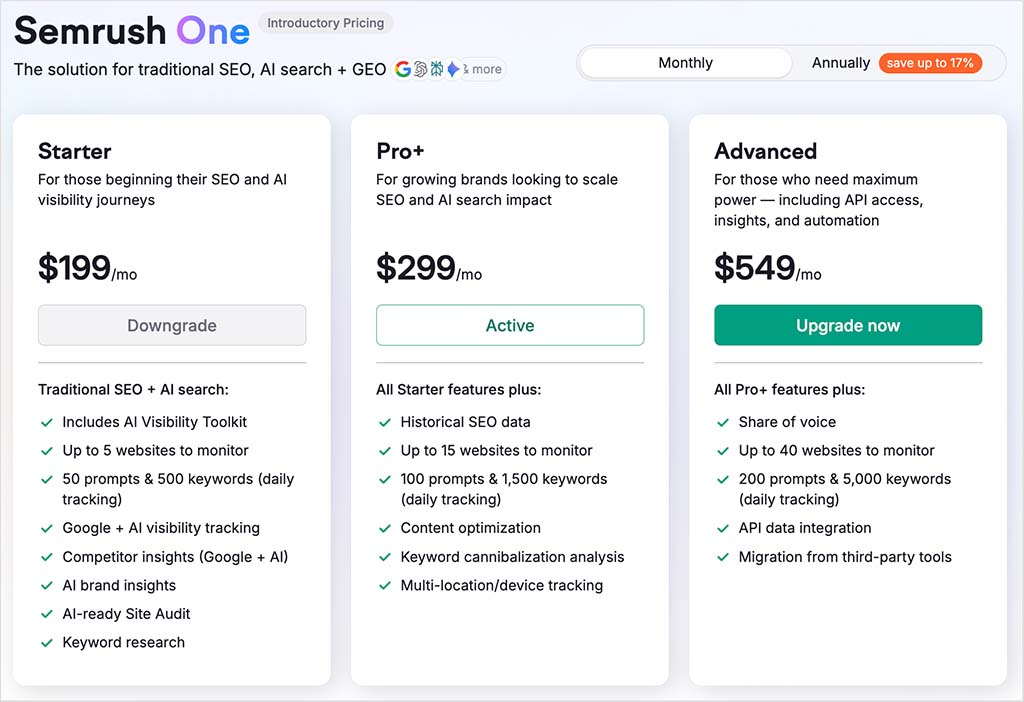
Now it has to be said that Semrush is considerably more powerful in both the SEO and AI department than most competing products — but even so, its price tag will definitely be offputting to some.
2. Only one user seat is included by default
All Semrush plans — including the Semrush One offerings — come with just one user account. If you have multiple team members who need access, you’ll need to purchase additional seats, and these can be expensive (each additional seat costs $45-$100 depending on chosen plan).
For agencies or collaborative content teams, this situation can lead to significant additional costs.
3. Many advanced features require additional paid toolkits
Despite Semrush One being considerably more expensive than the ‘SEO Classic’ Semrush plans, it still keeps several of Semrush’s most sophisticated tools behind separate paywalls. Tools like Traffic & Market Analytics, the Social Media Toolkit and the Advertising Toolkit are only available as paid add-ons.
These add-ons can quickly push the cost of Semrush far beyond the base subscription price. For larger organizations, that may be acceptable — but smaller businesses may struggle with the additional fees involved.
4. AI visibility coverage does not yet extend to all major platforms
Semrush One’s AI visibility toolkit currently caters for ChatGPT Search, Google AI Overviews and Google AI Mode. However, it does not yet offer visibility tracking for platforms like Claude, Perplexity or Meta AI, all of which are increasing in popularity.
As consumer behavior fragments across multiple AI assistants, coverage gaps like these will matter more. Semrush is likely to expand its support for these AI tools in future — but for now, its AI visibility tracking is incomplete.
5. Keyword research data is Google-only
Semrush doesn’t provide keyword data for search engines other than Google.
While Google remains the dominant player globally, this limitation becomes more significant in local markets where other engines hold stronger shares.
In particular, it would be good to see a bit more focus on the Bing search engine (given OpenAI’s involvement with it).
6. The mobile experience could be better
Semrush’s desktop interface is powerful, but it does not adapt well to mobile screens — if you want to use it on a smartphone, be prepared for a lot of pinching and zooming.
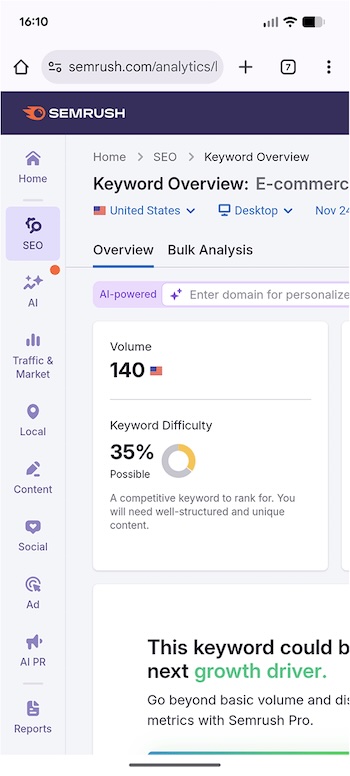
And while Semrush provides an iOS-only position tracking app, its functionality is limited. Users who want to check rankings, research competitors or audit sites on the go may find the experience frustrating.
7. Broken link analysis feels overly manual
Although Semrush can identify broken backlinks, finding them requires more steps than in competing platforms.
Rather than getting a simple, consolidated report, you often need to export data and filter it manually. While not a deal-breaker, this makes the workflow less streamlined than it could be.
8. Project limits restrict how much you can track
Semrush One — like Semrush’s classic plans — imposes limits on the number of websites (or ‘projects’) you you can track concurrently.
And because many key features operate on a per-project basis, users needing to work with multiple domains may find these limits restrictive unless they upgrade to higher tiers.
How much does Semrush One cost?
Semrush One is available in three core tiers:
- Starter: $199 per month
- Pro+: $299 per month
- Advanced: $549 per month
Each tier increases allowances for tracked keywords, tracked prompts, projects, and historical data access. The Advanced plan also includes API access, which is often important for larger organizations (and essential for those integrating Semrush data into custom dashboards).
Semrush also continues to provide an ‘SEO-only’ version of the platform, in the form of its ‘SEO Classic’ plans. These are priced as follows:
- Pro: $139.95 per month
- Guru: $249.95 per month
- Business: $499.95 per month
The main difference between the SEO Classic plans and the Semrush One options is that the SEO Classic ones do not include the AI visibility toolkit. To add this to an SEO Classic plan, you must pay an additional $99 per month per domain fee — making the total cost higher than simply opting for Semrush One.
So, for users who care about AI visibility — which increasingly should be most businesses — Semrush One offers much better long-term value.
Semrush offers free trials for its tools, although you must enter payment details to access the full feature set.
Semrush One user reviews
So far in this review, you’ve read my views on Semrush One. But what about the wider reaction to the tool? To help you get a sense of real-world user feedback, I’ve collated data from popular review sites. At time of writing (November 2025), the user ratings I was seeing across comparison sites was as follows:
| Review site | User rating |
| Capterra | 4.6 out of 5 (2,299 reviews) |
| G2 | 4.5 out of 5(2,906 reviews) |
| Trustpilot | 2.3 out of 5 (1,090 reviews) |
| TrustRadius | 4.4 out of 5 (767 reviews)* |
| Average user rating: | 3.9 |
* score originally out of 10, but recalculated as an out of 5 score for clarity
Overall, Semrush achieves an average rating of 3.9 out of 5 across these four comparison sites, based on 7,062 reviews (Trustpilot users being largely to blame for lowering the score!).
One thing that you should note however is that these reviews relate to Semrush in general, not a specific version of it (i.e., some reviews may be for Semrush One; but given that Semrush One was only recently released, most will be for the ‘classic’ version of the platform).
Semrush One: the verdict
By combining traditional SEO tools with a robust suite of AI visibility features, Semrush One amounts to one of the most forward-looking visibility platforms available today. It provides an exceptional amount of data, analysis and strategic guidance under one roof.
There are some downsides to consider though: the platform is expensive, particularly so if you need extra seats or want to avail of key add-ons. And its AI visibility coverage, while impressive overall, has some significant gaps.
Perhaps the most compelling reason to use Semrush One is that it helps you align your brand’s visibility strategy with the direction the industry is clearly moving in. Search is transitioning from lists of links to instant answers, generative summaries and conversational responses; understanding how your brand appears in AI outputs is becoming ever-more important, and Semrush One’s feature set, while not yet perfect, gives you important tools that help you do just that.
As ever though, the best way to find out if the new Semrush One offering is for you is to try it out yourself — and you can access an extended free trial of the platform here.
No comments